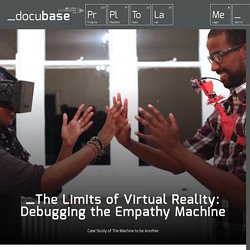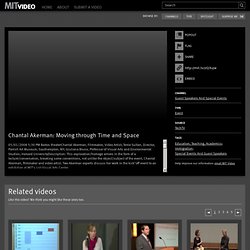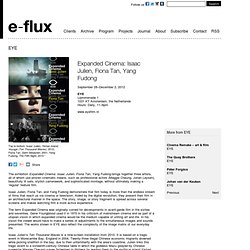

Best Motion Graphics Short Films. The Limits of Virtual Reality: Debugging the Empathy Machine. By Ainsley Sutherland “If you grip the handles, sir, you will… share his suffering, as you know, but that is not all.

You will also participate in his… World-view’ is not the correct term. Ideology? No. […] No word will do, and that is the entire point. It cannot be described — it must be experienced.” — The Little Black Box, by Philip K. The Machine to be Another is a performance piece that could almost be drawn from the eerily prescient world of 1960s science fiction. Through this experience, the designers and their collaborators hope to build empathy in participants. Borghese Galleria.
World Mirror Cinema, Episode 1 – 3. » Montage as Resonance: Chris Marker and the Dialectical Image. Shortly into the second part of Chris Marker’s epic 1977 compilation film Le Fond de l’air est rouge, one of the great acts of montage in the history of the cinema takes place.

After presenting us with a prolonged sequence shifting from newsreel footage of Soviet tanks freeing Prague from Nazi occupation in 1945 to the same tanks returning to the city 24 years later, this time not to liberate the city, but to crush the political aspirations unleashed by the Prague Spring, Marker homes in on an emblematic scene from this event. Czech citizens and news crews huddle around a callow Red Army soldier as he emerges from a tank, and implore him not to acquiesce in the invasion.
Invoking an innate sense of solidarity from the youth, stupefied by the attention he has suddenly been given, the Czechs attempt to pierce through the shroud of incomprehension by calling out to him in the few words of Russian they know – from within the crowd, cries of “Comrade! Brother!” Can be heard. Figure 1 Figure 2. Intime Conviction. 64 Sites for Digital Storytelling Tools and Information. StoryCode: Immersive Storytelling.
Chantal Akerman: Moving through Time and Space. 05/01/2008 5:30 PM Bartos theaterChantal Akerman, Filmmaker, Video Artist; Terrie Sultan, Director, Parrish Art Museum, Southampton, NY; Giuliana Bruno, Professor of Visual Arts and Environmental Studies, Harvard UniversityDescription: This exploration/homage arrives in the form of a lecture/conversation, breaking some conventions, not unlike the object/subject of the event, Chantal Akerman, filmmaker and video artist.

Two Akerman experts discuss her work in the kick"off event to an exhibition at MIT's List Visual Arts Center. First, Giuliana Bruno offers history and perspective on Akerman's oeuvre, starting with her pathbreaking 1975 film, Jeanne Dielman, 23 Quai du Commerce, 1080 Bruxelles , which "changed the way we looked at film, and opened up ideas for feminist thinking, theory and filmmaking. " Bruno discusses Akerman's unique way of breaking down barriers between documentary and fiction film, and more recently between film and museum installations. Credit license MIT TechTV. Ghosts of Hollywood [THE DECAY OF FICTION] Motion graphics, animation, vfx and live-action direction for film and television - Onesize. Great Performances . Don Giovanni Unmasked. Featuring one of the world's most sensational young baritones, Russia's Dmitri Hvorostovsky, this inspired adaptation of "Don Giovanni" retells the Mozart masterpiece from the point of view of Don Giovanni's servant, Leporello.

Taking the form of a film within a film, DON GIOVANNI UNMASKED is simultaneously set in two separate eras -- 1930s Hollywood and 17th-century Spain. When it opens in 1930, Leporello is presented as the host of a movie that reveals the long-standing secret of his master's identity in 1620 Seville. Through the intricate use of special visual effects, Hvorostovsky performs both roles of Leporello and Don Giovanni, transcending time and space to offer a tantalizing new perspective on Don Giovanni and his ultimately tragic romantic escapades. Click here to explore the Web companion for this program, which originally aired on April 6, 2001. Webdocs. Expanded Cinema: Isaac Julien, Fiona Tan, Yang Fudong. The exhibition Expanded Cinema: Isaac Julien, Fiona Tan, Yang Fudong brings together three artists, all of whom use proven cinematic means, such as professional actors (Maggie Cheung, Johan Leysen), beautifully lit sets, stylish camerawork, and sophisticated montage, without ultimately making a ‘regular’ feature film.

Isaac Julien, Fiona Tan, and Yang Fudong demonstrate that film today is more than the endless stream of films that reach us via cinema or television. Aided by the digital revolution, they present their film in an architectural manner in the space. The story, image, or story fragment is spread across several screens and makes watching film a more active experience. The term Expanded Cinema was originally coined for developments in avant-garde film in the sixties and seventies. Gene Youngblood used it in 1970 in his criticism of mainstream cinema and as part of a utopian vision in which expanded cinema would be the medium capable of uniting art and life.